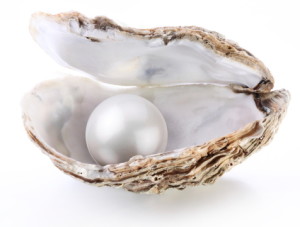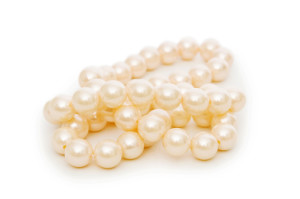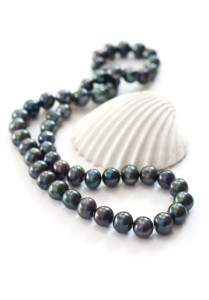Pearls
The Making of a Natural Pearl

A Pearl is an organic treasure produced by shellfish of the mollusk and oyster families.
When an irritant as simple as a grain of sand becomes trapped inside its shell,
the mollusk relieves the irritant by encasing it, layer upon layer, in a soothing
coating called nacre. Over a period of years the layers of nacre become a pearl.
Rare treasures in their own right, pearls were used to capture the love, gain the
attention, or show reverence for the most beautiful and powerful women of antiquity,
including Cleopatra, Helen of Troy, Elizabeth I, Catherine the Great and Marie-Antoinette.
A necklace made of natural pearls matched in size, shape and color is something
so rare and coveted that it could only be worn by a woman who was both financially
and politically secure. However, with the introduction of cultured pearls, Jacqueline
Kennedy, Audrey Hepburn, and Princess Diana have added to the pearl’s iconic status,
and made them available to all women.
Cultured Pearls

Around 1916, the process of manually inserting objects into a mollusk (such as a
round millimeter bead) upon which nacre would be naturally applied was perfected.
The pearls that resulted from this process are called cultured pearls and they account
for 99% of all pearls sold today. The predominant cultured pearls on
the market today fall into the following categories:
-
Akoya Pearls
Akoya Pearls are produced in salt water by the smallest pearl producing oysters. While they are
the best to match in color and size, the Akoya oyster rarely produces a pearl larger
than 8 mm.
-
Tahitian Pearls

Tahitian Pearls are produced by the salt-water black lipped oyster which naturally produces darker
hues, such as grey, silver, and even blackish-blue and purple.
-
South Sea Pearls
South Sea Pearls are cultivated along the warm seas from Northern Australia to East Asia. In
deep-Sea beds, these oysters produce the largest and most expensive cultured pearls.
Ranging in hues from creamy silver to a golden tone, these pearls can reach sizes
up to 20 mm with heavy nacre.
-
Freshwater pearls
Freshwater pearls have two major distinctions: they are produced by freshwater muscles; and because
they are produced by tissue cut from the producing muscle, they are completely composed
of nacre. Freshwater pearls have the widest varieties of size, shape and colors.
While the quality of freshwater pearls continues to be perfected, they remain more
affordable as each freshwater muscle can produce up to 40 pearls, while saltwater
oysters produce one to two pearls during their lifetime.
Wearing and Care of Pearls
Pearls should be worn at least once a month as body oils help them to maintain their
luster. Pearls traditionally should be the last item put on (always after make-up,
perfumes, and hairspray) and should be the first item removed. Should
pearls become dirty, they should be cleaned with a natural-bristled complexion brush
and a very mild warm soapy solution. Natural soap flakes should be used in
place of dishwashing soaps that are designed to strip oils. After the soapy solution
is applied by the soft complexion brush, the pearls should be submerged in cold
clean water for at least 5 minutes, then placed on a soft towel to dry naturally.
Pearls should be placed in separate silk bags or alone in felt jewelry box trays.
Pearl necklaces should not be hung as this will cause them to stretch and break.
Traditionally pearls are strung on silk or nylon cord that is knotted between each
bead. The knots hold the strands together in the event a break occurs.
Pearl strands should be inspected once a year to determine if stretching and weakening
of the strand has occurred.